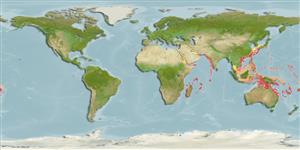Common names from other countries
>
Eupercaria/misc (Various families in series Eupercaria) >
Labridae (Wrasses) > Bodianinae
Etymology: Bodianus: Bodianus after Bodiano or Pudiano, from the Portuguese pudor, meaning modesty (Jordan & Evermann, 1896).; leucosticticus: The subgenus Peneverreo come from the Latin pene for near and verres for boar, in reference to the close relationships and similarity of colour patterns between members of this subgenus and those of the subgenus Verreo (Ref. 75973).
More on author: Bennett.
Environment: milieu / climate zone / depth range / distribution range
Ökologie
seewasser riff-verbunden; tiefenbereich 50 - 75 m (Ref. 90102). Tropical
Indo-West Pacific: Somalia, Mozambique, Natal (South Africa), Mauritius, Réunion, and southern Japan. Likely at Seychelles (Ref. 1623) if Lepidaplois luteopunctatus is a synonym of Bodianus leucosticticus.
Size / Gewicht / Alter
Maturity: Lm ? range ? - ? cm
Max length : 24.2 cm SL Männchen/unbestimmt; (Ref. 13277)
Rückenflossenstacheln (insgesamt) : 12; Rückenflossenweichstrahlen (insgesamt) : 10; Afterflossenstacheln: 3; Afterflossenweichstrahlen: 12. Adults reddish to purplish brown on head, body dull yellow; longitudinal row of 3 pale yellow spots along back; small black spot centered at base of caudal fin; 2 black spots on soft anal fin; large black spot on pelvic fins; blackish spot anteriorly on dorsal fin (Ref. 4392). Juveniles reddish brown with rows of white blotches and small spots; black spots on fins (Ref. 4392).
Adults are usually found at moderate depths (50 m). Oviparous, distinct pairing during breeding (Ref. 205).
Life cycle and mating behavior
Maturities | Fortpflanzung | Spawnings | Egg(s) | Fecundities | Larven
Oviparous, distinct pairing during breeding (Ref. 205).
Randall, J.E., 1986. Labridae. p. 683-706. In M.M. Smith and P.C. Heemstra (eds.) Smiths' sea fishes. Springer-Verlag, Berlin. (Ref. 4392)
IUCN Rote Liste Status (Ref. 130435)
CITES (Ref. 128078)
Not Evaluated
Bedrohung für Menschen
Harmless
Nutzung durch Menschen
Fischereien: weniger kommerziell
Tools
Zusatzinformationen
Download XML
Internet Quellen
Estimates based on models
Preferred temperature (Ref.
115969): 23.3 - 28.1, mean 26.9 (based on 81 cells).
Phylogenetic diversity index (Ref.
82804): PD
50 = 0.5000 [Uniqueness, from 0.5 = low to 2.0 = high].
Bayesian length-weight: a=0.01202 (0.00551 - 0.02625), b=3.05 (2.87 - 3.23), in cm Total Length, based on LWR estimates for this Genus-body shape (Ref.
93245).
Trophic level (Ref.
69278): 3.5 ±0.5 se; based on size and trophs of closest relatives
Widerstandsfähigkeit (Ref.
120179): mittel, Verdopplung der Population dauert 1,4 - 4,4 Jahre. (Preliminary K or Fecundity.).
Fishing Vulnerability (Ref.
59153): Low vulnerability (20 of 100).
